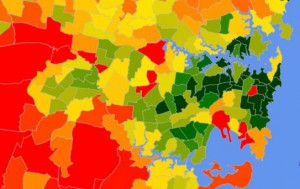A new US study shows a strong correlation between the number of local government authorities in a metropolitan area and the concentration of ethnic groups. The higher the number of councils per person, the more likely it is that ethnic groups are aggregated in particular localities rather than spread throughout the city.
The study is of the top 50 US metropolitan areas, but is relevant to Australia’s larger cities, which have many ethnic groups and – with the exception of Brisbane – many local councils.
The study, ‘Macro-Level Determinants of Local Government Interaction’, by University of Chicago Department of Public Administration academics Rebecca Hendrick and Yu Shi, was published in the prestigious Urban Affairs Review. The authors developed five indices to help them compare the concentration of ethnicities in various urban areas, based on the concentration of local government authorities.
The original article is behind a paywall and written in obtuse academese, but the London School of Economics has published a more accessible article by the authors summarising their findings. The bottom line is that cities with a large number of local councils tend to encourage ethnic clustering – a phenomenon sometimes known as ‘ghettoisation’, though the authors do not use that term.
The most fractured city in the US, they found, is Chicago, a large city whose ethnic neighbourhoods are legendary (“… the south side of Chicago / is the baddest part of town …”). Next come Pittsburgh and St Louis. New York is fourth on the list – its five boroughs are essentially separate cities with divergent ethnic characteristics.
“Populations will be more segregated on social and demographic characteristics across local government, especially at the municipal level, in regions that are highly fragmented,” say Hendrick and Shi.
“Local governments can interact competitively, which can affect their land use and taxation decisions in ways that harm the entire region. They can also collaborate to provide services and reduce common threats, and they can conflict with each other directly such as through lawsuits.”
They say that their five indices may yield clues about how local governments interact, and whether these interactions are beneficial or costly for individual governments and the region as a whole. Their indices are based on population, fiscal responsibility, fiscal autonomy, sociodemographics and ethnicity, and the rate of sales tax (which in the US is a local responsibility and revenue source).
They cite other studies based on their indices which show that local government fragmentation also correlates with other characteristics such as population density, the number of commuters who take public transportation to work, and the concentration of high-tech industries.
The study has relevance to the current Australian environment, particularly in the Sydney, which is Australia’s largest and most ethnically diverse city. Sydney is also – perhaps not coincidentally, given the findings of the study – the city with the highest degree of local government fragmentation.
The findings might provide further ammunition to proponents of council amalgamation, who can now add increased ethnic diversity to the list of supposed benefits.





Leave a Reply